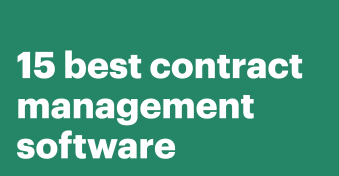The SaaSification of everything has made work easier for organizations by delivering the systems and applications they need as services.
But at the same time, having an extensive SaaS sprawl (across multiple teams) makes management a nightmare.
If your organization doesn’t provide management mechanisms to make sure all contracts are renewed, canceled, or updated on time, this could lead to service disruptions and revenue loss.
In this article, we’ll explain how to implement SaaS contract management in the modern workplace.
Key takeaways
- SaaS contract management involves keeping an administrative eye on all agreements with SaaS vendors.
- SaaS contract management helps your business optimize and automate tasks, scale faster, save more money, and improve customer experience.
- The right SaaS contract management tools will help secure your agreements while ensuring you make the best use of available features.
Challenges of managing SaaS contracts
Managing one SaaS contract is difficult, but proper oversight of multiple SaaS agreements is a complicated balancing act that many organizations let spiral out of control. Here is why:
- Vendors use different pricing models — which makes consolidating them into one flow a herculean endeavor. This extends to renewals for contracts with dynamic pricing and discounts.
- You need to monitor renewals for multiple platforms while juggling changing business needs with product price increases.
- Compliance with regulations such as GDPR and CCPA is an issue when managing contracts from different teams.
- Most SaaS applications are not interoperable. So choose a risk-free integration method or solution for syncing contracts.
- You must choose contract lifecycle management software with all the necessary features for tracking, data protection, and automating manual processes for your SaaS contracts.
Essential features for successful SaaS contract management
To manage your company’s SaaS contracts effectively, the software you choose must have the following features:
- Electronic signature solution for signatories to embed signature fields, stamps, and dates when negotiating SaaS contracts.
- Optical character recognition (OCR) is used to extract data from forms, contracts, and other documents.
- Integrations with third-party CRMs and ERPs for payments, data storage, and analysis.
- Analytical tools with a centralized dashboard containing a one-glance view of critical business and customer data.
- Templates for sample SaaS contracts, quotes (CPQ), proposals, and clauses in order to speed up the negotiation process.
- Security features such as authentication, authorization, and encryption protocols to protect sensitive data.
- Artificial intelligence for content generation and contract summary.
Benefits of SaaS contract management
Over 75% of businesses have experienced an improvement in workflow efficiency after implementing proper SaaS contract management. Here are other benefits.
Improve efficiency
Properly managing SaaS contracts will help organizations unify their SaaS sprawl in order to reduce the time spent on redundant, time-consuming admin tasks such as contract review, searching, updating, and signing.
Authorized users can rely on this system to create contracts using customizable templates.
They can also renew or terminate running end-user license agreements (EULAs) and get the right signatories to sign vital business or sales documents on time.
Keep services running
The contract management process involves the use of automation to streamline redundant tasks in workflows while keeping the business on regularly scheduled programming.
For example, an eCommerce website can rely on auto-renewals to ensure its continued operation after the hosting subscription reaches its end-of-term.
This means customers will have access to products or services without disruptions while your company decides how to settle the bills.
Increase visibility
Done right, managing contracts with different SaaS providers gives authorized stakeholders access to vital business data.
This usually comes in the form of centralized dashboards where they can track all actions on the contract. Consequently, this increased visibility breaks down information silos in organizations.
Automate agreements
Using an automated contract management platform gives you access to boilerplate contract clauses, instant renewal notifications, and event triggers for any changes during negotiation.
This means you no longer need to manually check when the contract is due or when a client has made edits to an agreement.
Automation also includes chatbots, which make self-service possible. You can embed AI assistants to help users generate clauses and complete contracts within seconds.
Let’s say you want to create a SaaS agreement. Here are the steps to follow:
Make slight edits to the necessary fields and sections. To speed up the process, use a SaaS terms of service generator.
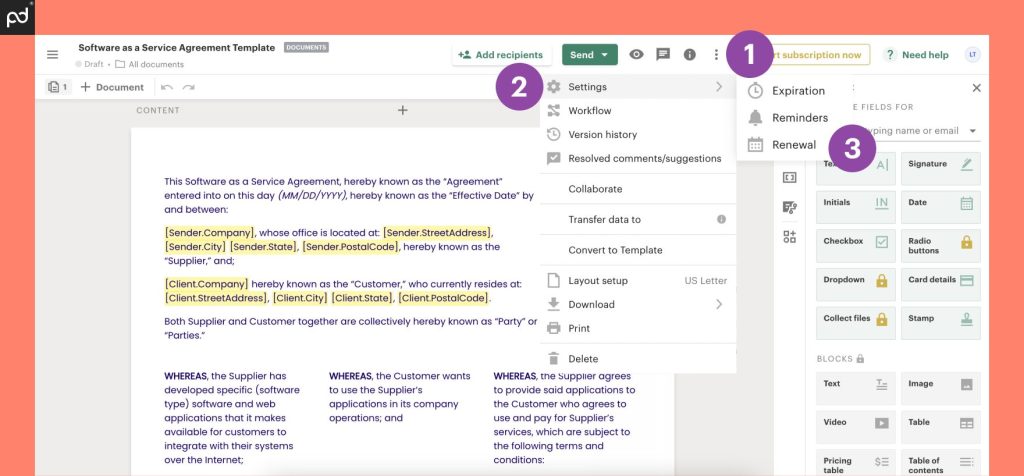
Embed all necessary fields, as well as pricing tables, explainer videos, signature fields, and payment options. Once done, send the document or invite signatories.
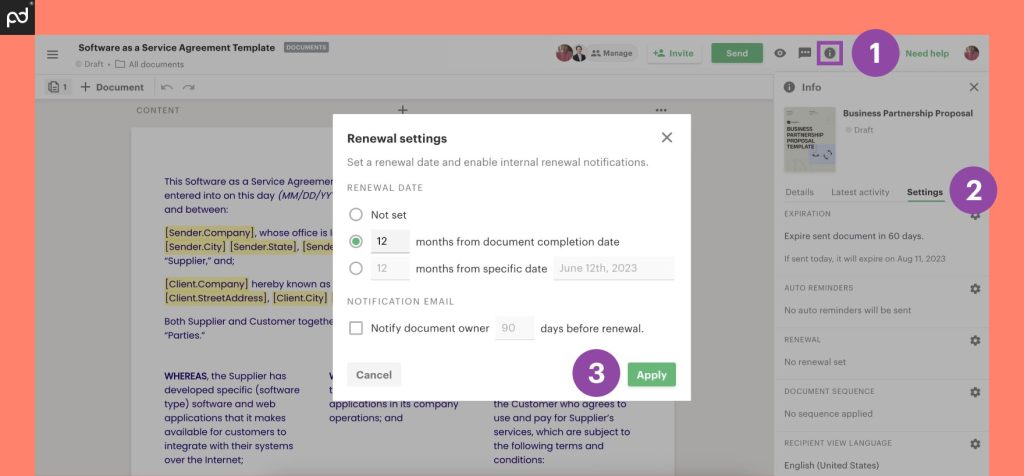
Set alerts, reminders, and expiration timers to notify stakeholders when to take action.
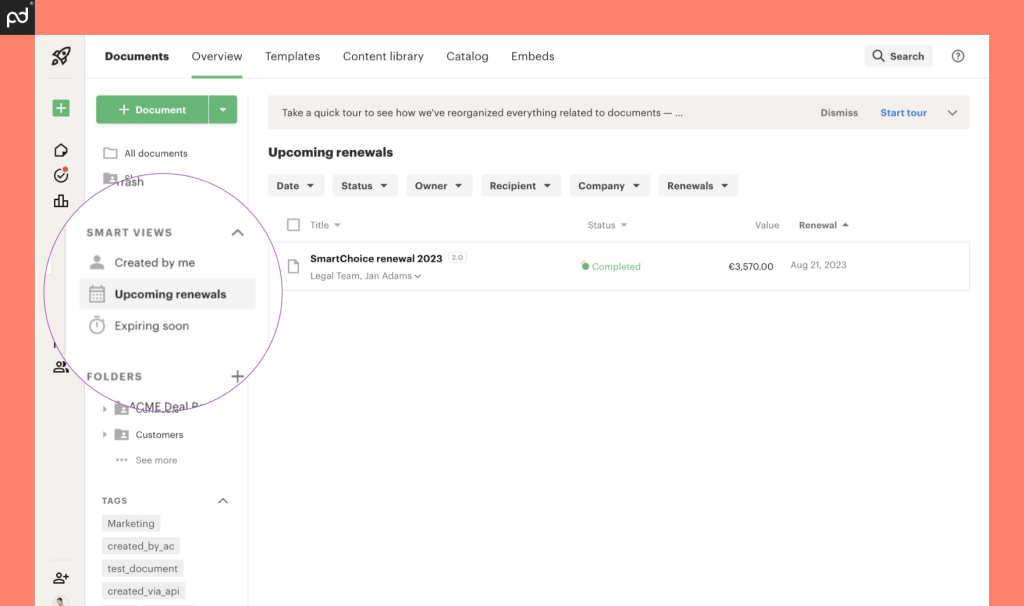
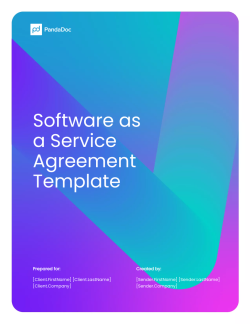
SaaS agreement template
Used 5072 times
The SaaS agreement template facilitates the use of the provider's exceptional software to assist with the company's daily operations.
Use this templateContract intelligence is also a product of automation. It allows you to analyze the contents and metadata of all contract fields to determine how best to draft and structure contracts.
Stay scalable
When you streamline contract administration for SaaS applications, your organization can scale operations to meet current demands.
For example, you can add another SaaS contract management platform to your tech stack since you now have a mechanism for keeping them all compliant and operational.
Save money
Managing SaaS contracts with a solid plan will help your business reduce expenses.
For starters, you get a better view of all the applications that are not in use, but you are still paying for.
One thing to bear in mind is the pricing model. Some options for pricing include:
- Subscription
- One-time payment
- Pay-per-use
- Pay-per-user
For cyclical pricing models, always monitor your spending to know when it exceeds the budget — and make the best of free trials and discounts.
This brings us to the issue of auto-renewals. To guarantee continuous service availability, companies sign up for automatic contract renewals.
This means you might be paying for services your team no longer needs.
However, a SaaS contract management system will notify you about upcoming renewals, price changes, and available discounts.
This will help you tailor your expenses to current business needs.
Integrate with third-party systems
A contract management platform allows users to embed third-party integrations.
For example, you can integrate your Salesforce CRM to monitor all accounts.
Also, you can embed an electronic signature solution across your organization.
Compliance teams can integrate monitoring tools in line with industry regulatory standards in order to stay updated about risks and contractual obligations.
Generate valuable insights
Consolidating all your SaaS contracts centralizes data from all your apps and systems, which you can synthesize for detailed, valuable business insights.
As mentioned earlier, you can integrate contract data management solutions and analytical tools to gather valuable insights such as missed renewals, churn rate, cancelation rate, pending deals, closed deals, and other vital metrics.
Stay compliant and secure
One key aspect of owning a SaaS contract is complying with general data handling, data residency requirements, and other industry-specific regulations. Most SaaS solutions handle compliance individually — without transparency, it may be difficult to monitor changes to standards.
However, a SaaS contract management solution can help you properly track compliance to meet regulatory requirements, internal policies, and industry standards.
This will protect your business from unauthorized access, data breaches, fines, service disruptions, and other risk factors.
After all, 85% of companies only want to work with companies that prioritize compliance.
Best practices of SaaS contract management
Here are some pro tips to help you optimize SaaS contract management.
- Set reminders and alerts: Use alerts to stay updated about upcoming renewals, user actions, and closed deals. These reminders can also notify you when to review agreements with vendors.
- Embrace SaaS renewal best practices: Remove credit card details to prevent auto-renewals of non-critical services. Toward the end of every contract lifecycle, negotiate a new SLA.
- Review contracts regularly: Hire a legal practitioner to help your organization keep track of the contract terms, scopes, milestones, usage rules, and renewal dates.
- Vet your SaaS service providers: Before choosing a vendor for any SaaS platform, review the terms of their SLAs and EULAs, as well as their track record with support, compliance, data security, and privacy. This will give you the upper hand during SaaS contract negotiation.
- Improve security: Use additional firewalls, role-based access controls, multi-factor authentication, and security protocols to beef up the security of data in storage.
- Watch out for vendor lock-in: If possible, avoid long-term contracts for non-core projects and processes. This will give you a clean decoupling strategy from vendors when you decide to terminate your contract.
- Perform regular audits: Establish a timeline for auditing all your contracts to ensure they still reflect your needs.
- Monitor SaaS performance: As part of regular auditing, you have to track metrics such as close rate, lifetime value, volumes, turnaround time, and others.
- Integrate third-party CRMs: To maximize the value of consolidating your contracts, you should integrate CRMs such as Zoho, HubSpot, and Salesforce.
- Choose the right tool: The perfect contract management software should have a secure contract repository and an electronic signature solution. It should also offer document automation, contract intelligence, and customization functionality.
Following these SaaS contract best practices will help your business improve process efficiency and protect sensitive data.
To start using PandaDoc for SaaS contract management, book a quick demo right away.
Disclaimer
PandaDoc is not a law firm, or a substitute for an attorney or law firm. This page is not intended to and does not provide legal advice. Should you have legal questions on the validity of e-signatures or digital signatures and the enforceability thereof, please consult with an attorney or law firm. Use of PandaDoc services are governed by our Terms of Use and Privacy Policy.


